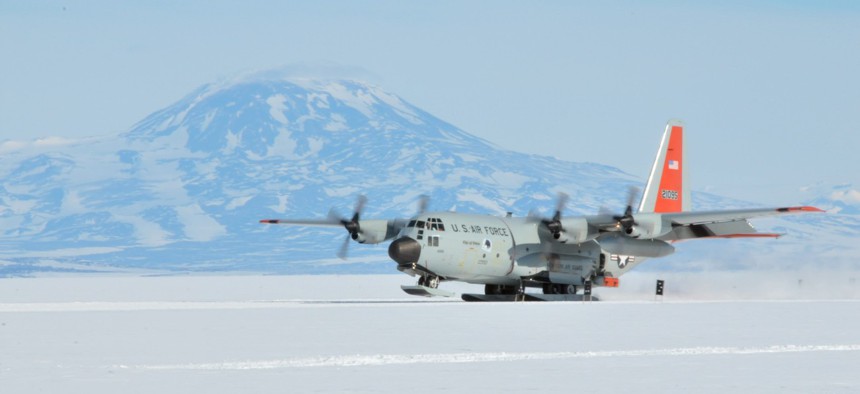
An LC-130 “Skibird” with the 139th Expeditionary Airlift Squadron returns to McMurdo Station, Antarctica, from an IcePod mission in November 2017. Master Sgt. Catharine Schmidt / U.S. Air National Guard file photo
Expect More Wargames, Attention and Allies in the Arctic, Say Air and Space Force Chiefs
The first Arctic strategy of the Space Force era declares the region vital for US satellites and nuclear missile defenses — and in need of a lot of foreign help.
For future U.S. Space Force operations, the Arctic will be “key terrain” according to Gen. John Raymond, chief of space operations. It’s also an area where the United States is especially reliant on NATO allies and partners. That means Americans should expect an increase in international military exercises and more spending on interoperable electronic communications, Raymond and Air Force leaders said today, as they revealed the Pentagon’s new Air Force Arctic Strategy for their service branches.
Space Force and the Air Force fall under the Department of the Air Force (much like the Department of the Navy governs the U.S. Navy and Marine Corps.) On Tuesday, Air Force and Space Force leaders highlighted the sensitive importance of the Arctic to U.S. missile defense and satellite operations. The United States operates 50 early warning radars and missile defense radars in the Arctic. Just below the Arctic Circle, at Alaska’s Fort Greely, are 40 ground-based midcourse defense interceptors that are meant to shoot down incoming intercontinental ballistic missiles. A shot over the Arctic is a much more direct route to the United States for Russia, China, or North Korea.
But the Arctic is also a key post for managing satellites, according to Raymond. “If you’re going to command and control satellites that are in polar orbits, where better to do that than on top of the world at the pole,” he said. “The geography and position on the globe makes it an extremely advantageous place to operate from,” even if the Arctic does present what the strategy document describes as ‘arctic-unique orbital mechanics and electro-magnetic obstacles’ that the Air Force must overcome. Read that to mean a lot of physics phenomena that don’t happen elsewhere on earth.
The Arctic is also becoming more congested as changing temperatures make parts of it more accessible — especially for Russia. Russia has always been a heavy player in the region and derives 25 percent of its GDP from Arctic activities according to the strategy. “Russia’s recent Arctic initiatives include refurbishing airfields and infrastructure, creating new bases, and developing an integrated network of air defense, coastal missile systems, and early warning radars to secure its northern approaches. Further, Russia seeks to regulate maritime traffic on the Northern Sea Route in ways that may exceed its authority permitted under international law,” notes the strategy.
Air Force Chief of Staff Gen. David Goldfein said that the Air Force will be exercising more actively in the region, pointing to four red-flag exercises that the service runs on a yearly basis as well as last year’s Arctic Challenge, which, he said, saw 140 different aircraft from nine nations and 4,000 participants.
“I do see an increase in activity relative to building on this strategy to ensure airmen are prepared to go anywhere, globally, as an expeditionary force,” he said. “What I tell them: I don’t know exactly when I am going to ask you, squadron commander, to pick up, pack up, and deploy forward to either 120 degrees plus, or 50 degrees minus. I just know we have to get you ready.”.
Increased Air Force traffic to the region also means more use of the Air Force’s LC-130s, which are essentially a C-130 cargo plane with skis, Goldfein said.
The biggest area of investment for the Air Force in future arctic operations is not cold-weather specific, it’s improved networking between different parts of the Air Force and between the United States and its allies -- an area Goldfein has spent years spearheading. The Defense Department is “focusing on the integration of capabilities, missile warning, space capabilities, air capabilities… how you marry up 5th generation [aircraft] with 4th generation [aircraft.] It’s more the case as we look to the future of warfare that data will be the currency that we operate on…. Perhaps most importantly in this region, it’s sharing data with allies and partners,” he said.
Among the Arctic states, Canada, Denmark (which owns Greenland), Iceland, and Norway, are NATO allies, and two others, Finland and Sweden, are NATO Enhanced Opportunities Partners.
The strategy describes the need to increase training with regional partners and establish new forums with allies to discuss Arctic issues, but does not specify if the United States wants NATO or any other international organization to take that lead role, as some are advocating “Building these relationships counters influence from adversaries, whose actions are not aligned with U.S. interests, and bolsters U.S. national security,” it reads. “The Department of the Air Force must work to highlight shared goals, ensuring a peaceful and stable region where international norms and standards are upheld. To strengthen collaborative international security relationships.”
The Air Force is “focused on this integration of capabilities,” Goldfein said, “...how we build the networks we can operate seamlessly on is where you are going to see most of our investment.”
The Air Force is “focused on this integration of capabilities,” Goldfein said, “...how we build the networks we can operate seamlessly on is where you are going to see most of our investment.”







